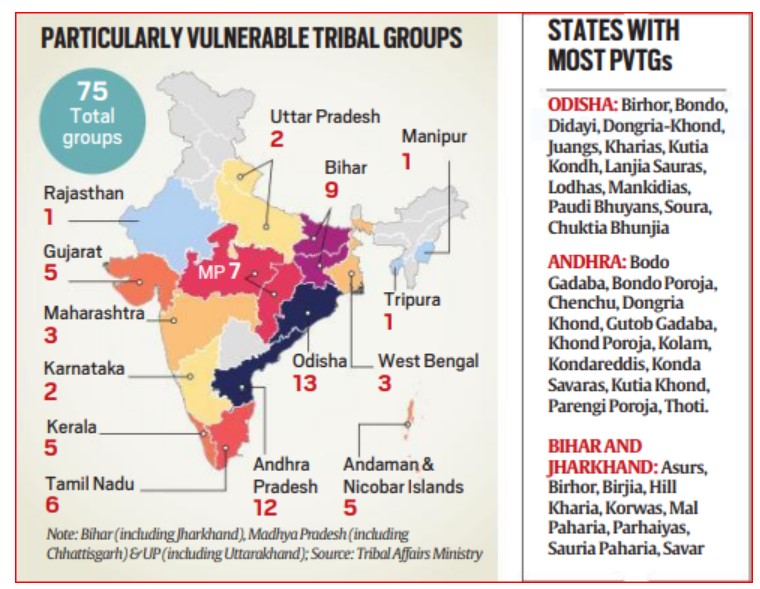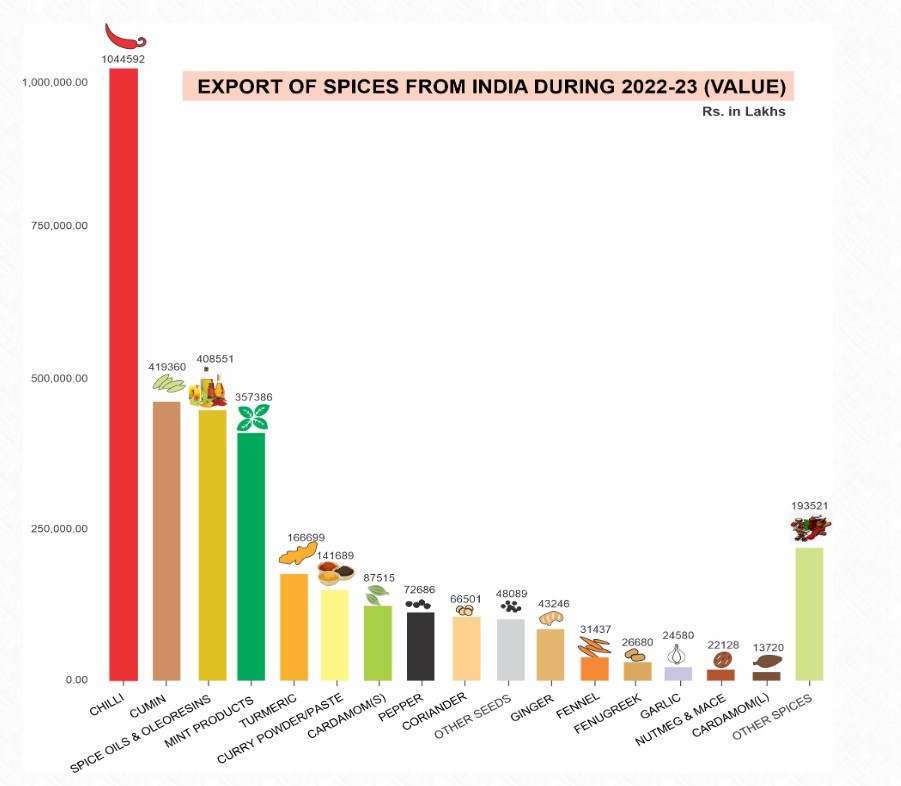CONTENTS
- Pradhan Mantri Janjati Adivasi Nyaya Maha Abhiyan (PM-JANMAN)
- What is the Current Status with Respect to Spice Exports?
Pradhan Mantri Janjati Adivasi Nyaya Maha Abhiyan (PM-JANMAN)
Context:
India is home to numerous Adivasi groups, with 75 classified as Particularly Vulnerable Tribal Groups (PVTGs) across various states. According to official data, these groups consist of approximately 14.6 lakh households. These tribes live in scattered, remote, and often inaccessible areas, relying on pre-agricultural methods and tools for their livelihoods. They also experience low literacy rates, economic backwardness, and stagnant populations.
Relevance:
GS2-
- Issues Related to SCs and STs
- Government Policies and Interventions
Mains Question:
If set right, the PM JANMAN can be an opportunity to transform the lives of India’s Particularly Vulnerable Tribal Groups. Discuss. (10 Marks. 150 Words).
Pradhan Mantri Janjati Adivasi Nyaya Maha Abhiyan (PM-JANMAN):
- Recognizing their disadvantaged status, the Government of India announced the Pradhan Mantri PVTG Development Mission for 2023-24 to enhance their socio-economic conditions.
- As part of this initiative, the Pradhan Mantri Janjati Adivasi Nyaya Maha Abhiyan (PM-JANMAN) was launched in November 2023 with a budget of ₹24,000 crore.
- The PM JANMAN aims to provide essential services to PVTGs, including safe housing, clean drinking water, and sanitation through 11 critical interventions.
- However, PVTGs and frontline officials face challenges in using a mobile application to register for the ‘Housing scheme,’ the largest Direct Benefit Transfer (DBT) scheme within PM JANMAN, which targets 4.90 lakh PVTG households by 2026.
- The objective is to ensure that every PVTG household has access to secure and habitable housing, protecting them from environmental challenges and providing a sense of security.
- Each household under the scheme is entitled to receive ₹2.39 lakh in three installments.

The Consequences of Data Mismatch:
- Data collection during registration in Direct Benefit Transfers (DBTs) is crucial for delivering entitlements to citizens.
- This importance is underscored by issues such as the widespread wrongful deletions of Mahatma Gandhi National Rural Employment Guarantee Act (MGNREGA) workers and the suspension of Pradhan Mantri KIsan SAmman Nidhi (PM KISAN) entitlements, often due to mismatches between registration details and Aadhaar records.
- A ground level analysis of the community members and frontline officials involved in implementing the scheme in Andhra Pradesh, Jharkhand, and Odisha reveals that the PM JANMAN Housing scheme faces inclusivity and accessibility challenges for PVTGs and frontline officials.
Issues with App Use and Confusion:
- The Government of India has provided an ‘Awaas+’ mobile app for block/panchayat-level officials to register PVTG households for the PM JANMAN Housing scheme.
- The app collects beneficiary data in three key areas: it records the geographical location of households, including block, panchayat, and village; it captures household profiles with geo-tagging for planned construction locations; and it gathers bank account details for cash transfers.
- Having a job card is mandatory for PM JANMAN Housing registration. However, the deletion of over eight crore MGNREGA workers in the past two years, including some from PVTGs, has rendered many ineligible to register for the scheme.
- Additionally, numerous beneficiaries have reported cases of others registering with their job cards, exacerbating the issue.
- A notable aspect of the mobile app is the pre-populated list of villages. However, it was found that discrepancies exist between the number of villages listed in the app and those in MGNREGA job cards, causing confusion among beneficiaries and officials.
- For instance, the app’s dropdown menu lists 22 villages, while the MGNREGA Management Information System (MIS) lists 31 villages for ‘Vanjari’ Panchayat in Alluri Sitharama Raju (ASR) district in Andhra Pradesh.
- The app requires family member names as per Aadhaar but does not provide guidance on what to do if Aadhaar is unavailable.
- Additionally, the app does not explicitly capture information about PVTGs, defaulting to ‘ST’ [Scheduled Tribe] in the social category field. This results in non-PVTGs also registering, leading local officials to request certification from sarpanches/mukhiyas in some areas.
- In villages where PVTGs and non-PVTGs coexist, there have been instances of non-PVTG sarpanches/mukhiyas acting against PVTGs’ interests in providing certification. The geo-tagging option also causes issues due to network problems.
- The app prompts enumerators to choose between Cooperative Bank, Commercial Bank, or Regional Rural Bank. Each selection brings up a lengthy dropdown list of corresponding banks and branches, adding complexity.
- For example, selecting ‘Commercial Bank’ might present over 300 options, and choosing ‘State Bank of India’ for registration in Andhra Pradesh can show over 500 branch options. This process complicates registration for both PVTGs and officials.
Missing Key Bank and Suggestions for Improvement:
- Despite the Government of India’s initiative to establish India Post Payments Bank (IPPB) to improve banking services, especially in underserved areas, the app does not include IPPB in its list of banks.
- This omission is puzzling, given the Union Government’s emphasis on IPPB’s role in financial inclusion.
- To improve the scheme’s effectiveness, it is essential to streamline the registration process, update the app, and include IPPB as a banking option.
- Proactive measures to reinstate deleted job cards and community engagement initiatives, such as involving gram sabhas, can also enhance participation of PVTGs in the scheme.
Conclusion:
Despite various initiatives aimed at addressing their vulnerabilities, the narrative of PVTGs in independent India continues to echo Adivasi rights activist B.D. Sharma’s description of an “unbroken history of broken promises.” If properly implemented, the PM JANMAN could present a significant opportunity to transform PVTGs’ lives, helping them benefit from India’s growth story.
What is the Current Status with Respect to Spice Exports?
Context:
Last month, Hong Kong and Singapore recalled certain spice mix products from the MDH and Everest Group due to alleged high levels of the sterilizing agent Ethylene Oxide (ETO). In response, Indian authorities have initiated measures to ensure Indian spices meet the food safety standards of importing countries.
Relevance:
GS1-
- Distribution of Key Natural Resources across the world (including South Asia and the Indian sub-continent)
- factors responsible for the location of primary, secondary, and tertiary sector industries in various parts of the world (including India).
GS2- Effect of policies and politics of developed and developing countries on India’s interests
Mains Question:
What is the present status of spice industry of India? Why is the use of Ethylene Oxide a cause of concern and what alternative methods can be used in its place? (15 Marks, 250 Words).
Source of Contamination:
- A promoter of Lifespice explains that India uses ETO not as a pesticide but as a sterilizing agent to reduce microbial load in finished spice goods.
- Agro products, including spices, are often contaminated in mandies (auction yards for farmers) through contact with humans, birds, reptiles, and insects.
- Large factories receiving these materials often find them with high microbial levels, necessitating ETO sterilization. However, contamination can be reduced through early processes in value addition.
Scale of Indian Spice Exports:
- According to quick export estimates from the Spices Board India, India holds a significant share in the global spice market.
- In 2023-2024, India exported spices worth $4.4 billion (nearly 14 lakh tonnes), a 12.3% increase from the financial year 2022-2023.

- The United Planters Association of Southern India reports that the largest exported spices in 2022-2023 included chili, spice oils and oleoresins, curry powder and paste, cumin, mint products, cardamom, and pepper.
- In terms of production, garlic, ginger, and chili were the top spices produced in FY23. Major markets for Indian spices include China, Bangladesh, West Asian countries, and the U.S.
Impact of the Recall:
- An official from the Federation of Indian Spice Stakeholders noted that Singapore and Hong Kong had not banned Indian products but only recalled them.
- Exports to these countries have resumed, so there may not be a significant impact in the coming months. India accounts for about 70% of global spice production.
- Different countries have varying standards for ETO and maximum residue levels (MRL). The European Union has stringent norms for both, while Japan mainly sources organic products.
- The industry is urging the Indian government to negotiate with the EU to relax these norms to boost Indian spice exports.
- Some chili growers in Telangana believe the issue won’t significantly affect farmers since most do not export directly.
- Indian food exports have historically faced challenges due to the stringent standards of importing countries.
- A planter noted that cardamom and black pepper, grown as intercrops with tea, coffee, or rubber, meet stringent MRLs required for these main crops.
- Spice mix and paste manufacturers should source genuine Indian-grown spices rather than imported ones and be cautious when importing spices for value-added products, according to a cardamom grower in Kerala.
- A turmeric exporter from Erode, Tamil Nadu, pointed out that while ETO is allowed by the U.S., the EU prefers steaming for sterilization, which is significantly more expensive (₹20-₹25 per kg compared to ₹5 per kg for ETO).
- He suggested the Indian government should establish realistic guidelines and communicate them to buying countries.
Conclusion:
In response to the recall by Hong Kong and Singapore, the Spices Board has issued a detailed protocol to all manufacturing exporters to prevent ETO contamination. The Board also announced mandatory testing of spice consignments to Singapore and Hong Kong for ETO. Additionally, the Board is engaging with the international food standards body to establish a standardized ETO usage limit, as it varies by country.




